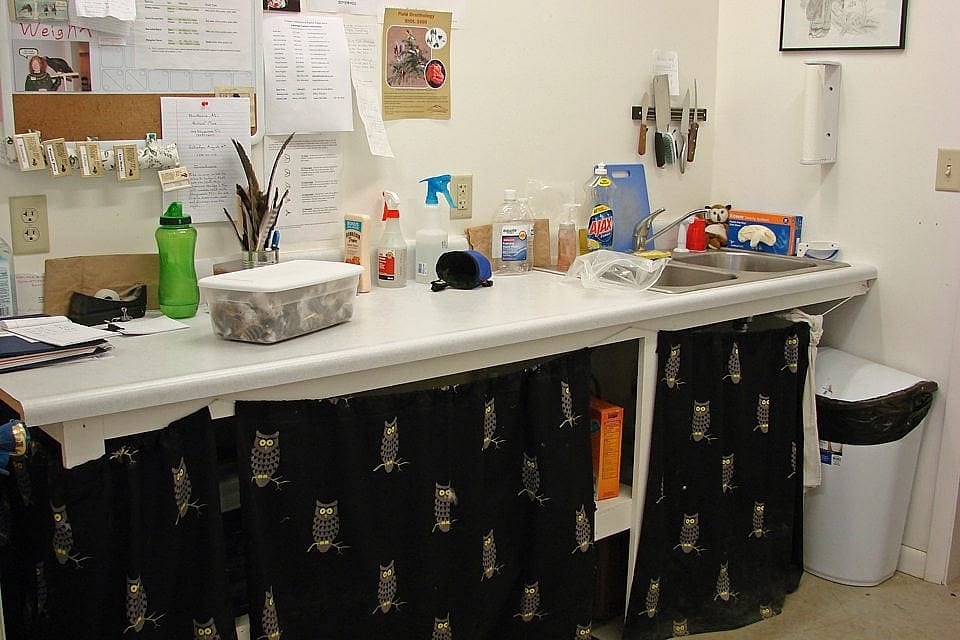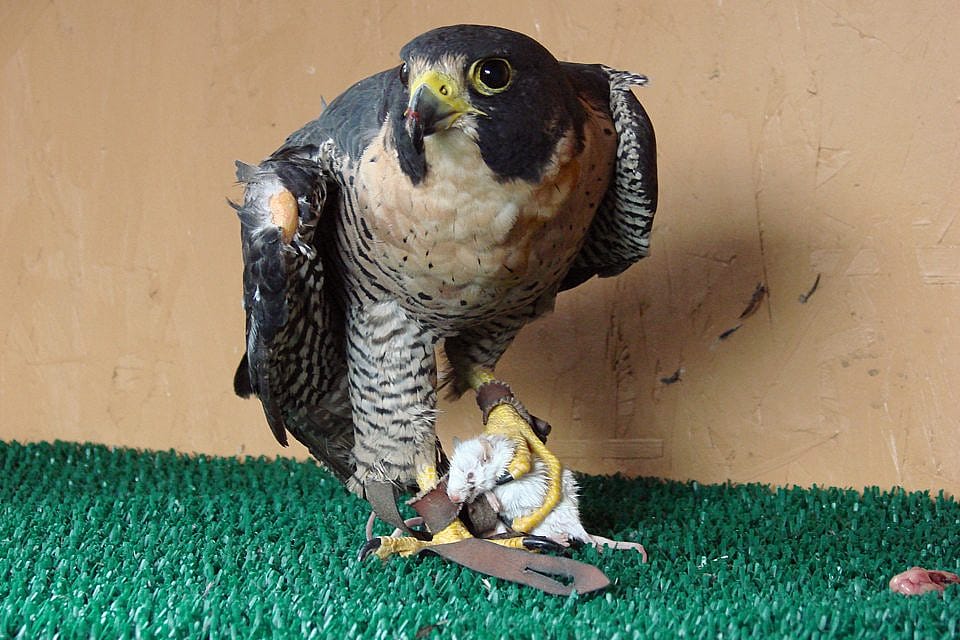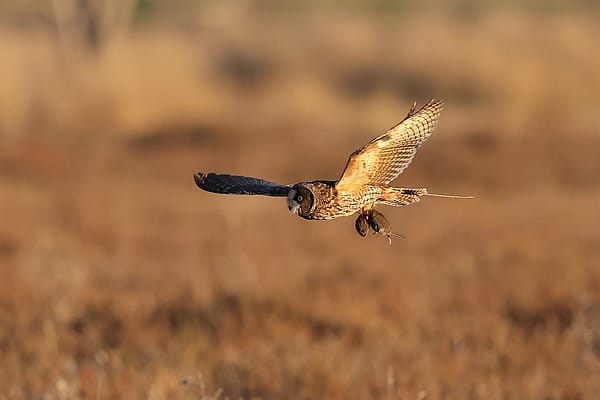
Feeding the birds – They’ll love me now for sure
One of the jobs that we agree to do when we volunteer as a bird handler is to help with feeding the birds. According to Christopher Hitchens, “Owners of dogs will have noticed that, if you provide them with food and water and shelter and affection, they will think you are God. Whereas owners of cats are compelled to realize that, if you provide them with food and water and shelter and affection, they draw the conclusion that they are gods.” I am not sure what our birds think, but I hope that they at least notice me when I arrive with their meal, and although it doesn’t cause them to love me, it will at least help them to accept me into their world.
Thankfully, we feed our birds commercially-purchased food, which arrives to us frozen. I was so worried that we were going to have to feed live animals, and having a soft heart, I didn’t think I could do that. Although this is frozen food, it still looks like the animal it is. We have chicks, mice, rats, quail, and rabbits, and they have not been processed at all, it is the complete animal.
Each bird’s weight is carefully monitored, so that they are neither too fat, nor too thin, therefore Melissa makes out a daily menu for each bird. Checking the menus before each feeding, we not only feed what is on that day’s menu, but also pull from the freezer what each bird will dine on the following day.
Last winter Melissa had Tuesdays off, so since I was going to be in the museum on those days working in the lab, I volunteered to feed the birds each Tuesday. As I entered the mews Tuesday afternoons, Haya would always look at me with interest and expectation. She seemed to have figured out that I would be delivering her dinner. Teasdale would usually ignore me, although sometimes he would slowly turn his head, check me out, then turn back to whatever he had been staring at. Isham pretty much ignored me, and would generally just keep standing regally on his perch, usually gazing out his window.

When I entered the work area, Suli would tap on her door, “Please, can I come out?” Sometimes she would become impatient and rattle the door and pound even harder. “I WANT OUT NOW!’ If I had the time, and the sun was shining in through the window, I would honor Suli’s request. Entering her mew she would eagerly step up on my glove and I would place her on a platform perch in front of the window where she spread her wings with joy, soaking up the sunshine. I am sure she was saying thank you. In the wild, vultures can often be seen standing in this horaltic pose, which warms them up, bakes off bacteria, and aids them in absorbing vitamin D. Suli doesn’t need the warming up, as she is the lucky bird that has two rooms: a warm weather room and a cold weather winter room. The cold weather room is located in the work room, which is the only area that is heated. Turkey vultures are warm weather birds, so we only have them in Cody in the summer time. After Suli has enjoyed her time out for a while, I place her back into her mew.
Before doing the feeding I would enter each mew, and check for any leftover scraps of food, dropped feathers, or pellets, recording these on each birds’ daily record sheet. If needed, before feeding Haya, I also picked up feathers that may have been left all over her shelf from her previous day’s meal. I then looked at the menu which Melissa had left to see what would be fed that day.
Both this past winter and now, if I see chicks and mice, then “YEH!” for we usually don’t cut these up, so they are the easiest. If I am feeding rats or quail, then these need to be cut up into the proper portions for each bird. We also have rabbits. So far I have yet had to cut up one of those. Although cutting up the food for each birds’ portion of the day is not my favorite job, it is not disgusting, either. And, after all, our birds need their dinners.
I am not a vegetarian, I do go to the grocery store and purchase meat. At home I cut up my beef for stews and chili and my chicken breasts for stir-fry. The difference is that at home I don’t have to look my food in the eye, as it has already been stripped of all features resembling the animal from which it came from. When I feed the birds, I rarely allow myself to think about these animals when they were alive, and think instead about how happy our birds will be to see their dinner arrive.
Haya, for one, seems to take great joy in plucking the feathers off of her quail when they are served up to her, and I believe that this gives her some stimulation. Feeding Haya chicks and quail that have not been stripped of their feathers gives her the same type of stimulation she would have if she were eating in the wild. Rats are my least favorite to cut up, as they can be pretty stinky inside. These are one of Teasdale’s favorite foods. Maybe that is why at times Teasdale’s breath is so bad, or is that just normal for great-horned owls? I am not sure.
Yes, our birds have their likes and dislikes. Our red-tailed hawk, Isham, is the pickiest eater in our little flock. In the wild, rabbit is one of their favorite foods, but our Isham won’t touch them. Ewwwwwww, don’t bring him rabbit, and also forget the chicks. Teasdale, who will pretty much eat anything in the wild of a size he can catch, including skunks, won’t eat quail. Our other birds aren’t as picky, although there are some favorite foods. Suli especially loves mice and, although she is less enthusiastic about rabbits, she will eat everything that we offer. Haya loves to eat and will also eat any of our regular offerings. In the wild 77 – 99 percent of a peregrine’s diet is birds and with us Haya is often fed chicks and quail, although she also loves mice. She is also excited by anything new that is brought in for her, such as part of a pheasant that one of our volunteers donated. We don’t generally accept game or fish donated by people, but this volunteer, who hunts and fishes, does not use led shot when she hunts, which, if ingested, can cause lead poisoning. Dying from lead poisoning is a slow and painful death. So if you are a hunter, remember our birds, and please leave the lead bullets on the shelf.
I always give Suli her meal first, as she is again tap-tap-tapping on her door, saying, “Feed me, feed me NOW!” Suli begins eating right away. She may mantle her food, placing her wings around it, just in case I may change my mind and take it away from her, even though this never happens. I then carry portions of food to the other birds and feed them.
The birds react in different ways when the food is brought to them.
Haya, the princess of the mews, hears me coming down the hall, she knows dinner is arriving. I hear her jump from her window perch to her feeding platform. As I peer in at her, she is standing expectantly on the edge of the platform staring intently at the door, quivering slightly. As I open the door, she may do one backward jump, eyes glued to what I have in my hand. Often it is quail, one of her favorites. As I lift it toward her, her eyes remain glued to the food item. She pounces upon it the instant I place it on the tray. If it is a quail, she is soon surrounded by a cloud of feathers that she is joyfully plucking, as she greedily tears into her dinner. For the moment, she has forgotten she is the princess, and has lost all etiquette. Making short work of her meal, she is now standing on a feather-covered platform, with bits of food stuck to her beak. She doesn’t look like royalty at the moment, however, she will soon feak (clean her beak on a perch), rouse (raising her feathers and shaking them back into place), and sometimes preen, returning to her former regal self.
Isham looks at me, then he looks at the food. He sometimes hops over and examines it to see what he is having that day. He may even grasp the food in a talon, however even though he seems interested in what I have delivered to him, I have never actually seen Isham eat. Isham tends to prefer eating in private. A few of us, however, have seen him enjoying his meal. So far with me, he has always waited until I leave for the day.
Teasdale just looks slowly at me and shows no reaction at all. That is until I enter his mew, then he states his feelings, “Hisss, hisss.” I go over to the platform that I feed him on, and dangle the food above it so that he can see it. He shows no interest, and often doesn’t even bother to look to see what I have brought him. He will save that investigation for later, as he always saves his meals until after everyone is gone. In the wild great-horned owls prefer to hunt at dusk or dawn, but if this doesn’t work out, they will also hunt in the dead of night. If they are hungry, a wild owl is not against swooping down out of their tree in the middle of the day to catch a nice juicy-looking owl-size critter. Teasdale, however, has room service, so eating in the day time is not necessary.
Question from Visitors:
Why don’t you feed them live animals?
Although in the wild, all but our turkey vulture would hunt and kill their own food, there is no need for that here. Our birds cannot be returned to the wild, there is no need for them to maintain their hunting skills. Also, with the exception of Suli, our birds have suffered debilitating injuries that make hunting difficult, if not impossible for them. Raptors can be injured by their prey if it is not killed quickly or if the struggling animal bites or scratches them. These injuries can cause infections and even death. There is no reason to put our birds into this danger.
Written By
Anne Hay
Anne Hay has a Bachelor's degree in Elementary Education and a Master's in Computers in Education. She spent most of her working years teaching third grade at Livingston School in Cody, Wyoming. After retiring she began doing a variety of volunteer work for the Buffalo Bill Center of the West’s Draper Natural History Museum. Anne loves nature and has a concern for the environment. She believes that educating the public, so that they will have a better understanding and appreciation for the natural world, is very important. Because of this belief, volunteering at the Center is a perfect fit. She spends time in the Draper Lab, observing eagle nests for Dr. Charles Preston’s long-term research project on nesting golden eagles, writing observation reports of raptor sightings in the Bighorn Basin, and working with the Draper Museum Raptor Experience. Anne states that, “Having a bird on my glove, is one of my all time favorite things in life.”
















